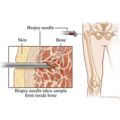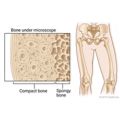Bone Biopsy
Test Overview
A bone biopsy is a procedure in which a small sample of bone is taken from the body and looked at under a microscope for cancer, infection, or other bone disorders. The sample of bone can be removed by:
- Inserting a needle through the skin and directly into the bone (closed or needle biopsy). A numbing medicine (local anesthetic) is used to prevent pain during this procedure. Intravenous (IV) pain medicine and a sedative medicine also may be given.
- Making a cut (incision) through the skin to expose an area of the bone (open biopsy). General anesthesia or medicine to block feeling in the area where the cut is made (spinal anesthesia or a nerve block) is given for this procedure.
A bone biopsy can be taken from any bone in the body. It is easiest to get the biopsy samples from bones that are close to the skin surface and away from any internal organs or large blood vessels.
A bone biopsy is often done on bone areas that show problems on an X-ray. Computed tomography (CT scan) or a bone scan may be used to guide the biopsy needle.
Why It Is Done
A bone biopsy is done to:
- Confirm the diagnosis of a bone disorder (such as Paget’s disease, a disease that may look like bone cancer, or bone cancer) that was found by another test, such as an X-ray, CT scan, bone scan, or a magnetic resonance imaging (MRI) scan.
- Tell the difference between a noncancerous (benign) bone mass, such as a bone cyst, and bone cancer, such as multiple myeloma.
- See what is causing a bone infection (osteomyelitis) or if an infection is present.
- Find the cause of ongoing bone pain.
- Check bone problems seen on an X-ray.
An open bone biopsy allows your doctor to do surgical treatment at the same time, if needed.
How To Prepare
Before having a bone biopsy, tell your doctor if you:
- Are taking any medicines. If you take medicines every day, ask your doctor whether you should stop taking these medicines before the test.
- Are allergic to any medicines, such as those used to numb the skin (anesthetics).
- Take a blood thinner, or if you have had bleeding problems.
- Are or might be pregnant.
- Take any herbal remedies. Some of these remedies may thin the blood.
Getting ready for a bone biopsy changes depending on the type of biopsy that will be done.
- For a closed biopsy (needle biopsy), you do not need to do anything before the procedure. Right before the procedure, you will be asked to remove most or all of your clothes. You will be given a gown to use. You will be awake during the procedure. Arrange to have someone drive you home because you may get a medicine (sedative) to help you relax.
- For an open biopsy, your doctor will tell you how soon before surgery to stop eating and drinking. Follow the instructions exactly about when to stop eating and drinking, or your surgery may be canceled. If your doctor has instructed you to take your medicines on the day of surgery, please do so using only a sip of water. You can eat your regular diet after the procedure. You may need to stay overnight in the hospital after an open biopsy is done.
You will be asked to sign a consent form that says you understand the risks of the test and agree to have it done.
Talk to your doctor about any concerns you have regarding the need for the biopsy, its risks, how it will be done, or what the results will mean. To help you understand the importance of this procedure, fill out the medical test information form( What is a PDF document? ).
How It Is Done
Closed or needle biopsy
A closed or needle biopsy is done in a hospital or clinic by a doctor who specializes in X-ray tests (radiologist) or by a surgeon who specializes in conditions of the bone (orthopedic surgeon).
During the biopsy, you lie on an examining table or firm bed. It is important to lie very still during the entire procedure. Tell your doctor if you need to move or get more comfortable. You may feel pressure or discomfort during the biopsy. A needle biopsy takes 15 to 30 minutes.
- Before a needle biopsy, an intravenous (IV) line may be put into a vein in your arm. You may be given a sedative to help you relax. You will be awake during the biopsy.
- Your doctor uses a special soap to clean the skin over the bone where the biopsy sample will be taken. The skin area may need to be shaved. Then your doctor gives you a numbing medicine (local anesthetic) in your skin.
- The radiologist or surgeon puts a long, thin needle through the skin into the bone. Your doctor may make a small cut in your skin before putting the needle in so the needle passes easily. Then your doctor takes out a small amount of bone through the needle.
- After a closed or needle biopsy, a small bandage is placed over the area and pressure is put on the area to stop any bleeding. After bleeding has stopped, medicine to prevent infection (topical antiseptic medicine) may be put on the skin. A clean bandage is put on the area.
- You will stay for a short time after the biopsy until your doctor says it is okay for you to go.
Open biopsy
An open biopsy is done in an operating room by a surgeon. During the biopsy, you lay on an operating bed. An open biopsy takes 30 to 60 minutes.
- Before an open biopsy, you will be given general anesthesia or medicine to block feeling in the area where the skin cut is made. You will have an intravenous (IV) line in a vein in your arm for medicines and fluids. Before making a skin cut, your surgeon uses a special soap to clean the skin over the bone where the biopsy sample will be taken. The area may need to be shaved.
- The surgeon makes a cut to see the bone and take out a small piece.
- After an open biopsy, the cut is cleaned and closed with stitches (sutures). A bandage is put on the area. The stitches are taken out about 14 days after the biopsy.
- You may need to stay overnight in the hospital after an open biopsy is done.
In rare cases a special test of your bone tissue (frozen section) is done while you are having an open biopsy. The bone taken for a frozen section is quickly frozen, thinly sliced, and looked at under a microscope. If cancer cells are seen, your surgeon may take out some more of the bone during the procedure.
How It Feels
Closed or needle biopsy
You may feel a brief pinch or sting from the numbing medicine. You may feel pressure or a brief, sharp pain as the needle enters the bone. You may also feel an aching pain or pressure when the bone tissue sample is taken out. After the procedure, the biopsy site may be sore and tender for up to a week. Your doctor will talk to you about pain medicine.
Open biopsy
You will be asleep or the area will be numb so you will not feel any pain. After the biopsy, you may feel sleepy for about 2 hours. The biopsy site may be sore and tender for up to a week. Your doctor will talk to you about pain medicine.
After a bone biopsy
- If a closed biopsy is done, you may go home shortly after the procedure. If you got a sedative, you may need to stay longer and have someone drive you home.
- If an open biopsy is done, you may need to stay in the hospital overnight. Arrange to have someone drive you to and from the hospital or clinic.
- A bandage will be placed over the biopsy site. You may be told to keep the biopsy site covered and dry for 48 hours. A small amount of bleeding from the biopsy site is normal. Ask your doctor how much drainage to expect.
Risks
Problems from a bone biopsy are rare. There is a very small chance that the biopsy needle may break (fracture) the bone or injure a nerve, blood vessel, or organ near the biopsy site. Surgery may be needed to treat the problem.
There is a very small chance for a skin infection or for the bone to become infected (osteomyelitis) or to not heal well. In rare cases, the bone may become weak and break (fracture) at a later time.
After the biopsy
Call your doctor immediately if:
- The biopsy site continues to bleed.
- You have signs of infection. These signs may include:
- Increased pain, swelling, redness, or warmth around the affected area.
- Red streaks spreading from the affected area.
- Drainage of pus from the area.
- Swollen lymph nodes in the neck, armpit, or groin.
- Fever or chills.
Results
A bone biopsy is a procedure in which a small sample of bone is taken from the body and looked at under a microscope for cancer, infection, or other bone disorders. It may take several days to get the results because the bone sample needs to be specially prepared for study.
|
Normal: |
The biopsy sample shows normal bone tissue. |
|
Abnormal: |
Bone tissue may show signs of infection, cancer, or another bone disorder (including Paget’s disease, osteomyelitis, a bone cyst, or a noncancerous [benign] bone growth called an osteoma). The bone tissue may also show osteoporosis or osteomalacia, which means the bones are weak. |
|
Most cancer of the bone spreads (metastasizes) to the bone from another part of the body, such as the breast, lungs, prostate, or other organs. But bone cancer can also start in the bone itself (such as osteosarcoma or Ewing’s sarcoma). |
What Affects the Test
Reasons you may not be able to have the biopsy or why the results may not be helpful include:
- Not being able to lie still during the biopsy.
- Having a condition that affects your immune system. This may increase your chance for an infection at the biopsy site.
- Not getting a good sample of bone tissue. A good sample may be hard to get to with a needle.
What To Think About
During a bone biopsy, the doctor may also take a sample of bone marrow (bone marrow biopsy). A bone marrow biopsy is done to check for infection in the bone marrow or to see why the bone marrow may not be healthy or to check for certain kinds of cancer, such as leukemia, lymphoma, or multiple myeloma. To learn more, see the topic Bone Marrow Aspiration and Biopsy.
Current as of: March 28, 2019
Author: Healthwise Staff
Medical Review:Adam Husney, MD – Family Medicine & E. Gregory Thompson, MD – Internal Medicine & Martin J. Gabica, MD – Family Medicine & David Bardana, MD, FRCSC – Orthopedic Surgery, Sports Medicine
This information does not replace the advice of a doctor. Healthwise, Incorporated, disclaims any warranty or liability for your use of this information. Your use of this information means that you agree to the Terms of Use. Learn how we develop our content.



